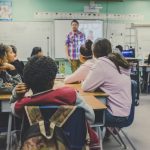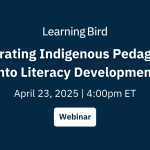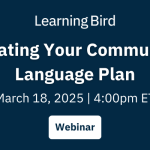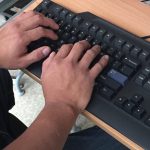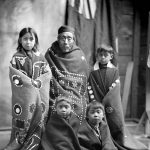Two Perspectives on Using Social Media in Education
Between Facebook, Twitter, Instagram, Snapchat, and whatever’s next, social media plays an integral part in most people’s lives these days. As an educator, it can be a challenge to keep track of what’s hot and what’s not (last year, my learners told me Facebook wasn’t “cool” anymore), and it is an even bigger challenge to know when and how to use social media in education. There are a lot of questions floating around about the best practices for incorporating social media in education, the role of educators in modelling its appropriate use, and how to teach learners to use it responsibly.
To answer these questions, we asked two social media rockstars, librarian Gwyneth Jones and administrator Tyler Tarver, about their approaches to using social media in their school and with their colleagues and learners.
Gwyneth Jones
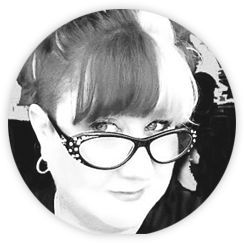
Gwyneth A. Jones, aka The Daring Librarian, is a blogger, Tweeter, international Ed Tech speaker, trope and meme archivist, creator of content, a citizen of advocacy, and resident of social media. Gwyneth is a Google Certified Teacher and author of the award-winning blog Daring Librarian. Jones is also a Library Journal Mover & Shaker, a Gale/Cengage New Leader, and was named the Best of the Best and a Visionary Leader by Teacher Librarian Magazine.
1. How do you use social media in your professional and personal lives?
There are so many social media outlets out there to choose from. It could either be a minefield or a diamond mine for connecting, sharing and creating your own Personal Learning Network or PLN.
I use social media only in a professional sense – to share the cool things that go on every day in my school and my library, celebrate my amazing students and connect with my parents and our local and global community.
In other words, I have purposefully and intentionally not used social media in any personal way. For some, that might seem like a sacrifice. For me, it’s been both a blessing and sort of a relief. That’s not to say that I don’t occasionally share some personal stuff. I blogged about my Twitter formula. I’d say I share about 82% ed tech and library information, 8% pop culture (Bravo Housewives, movies, gentle mocking of the Kardashians) and just 4% personal stuff. I don’t share personal stuff all the time. To me, that would be pointless, self-aggrandizing, and tiresome.
I recently blogged about the difference between sharing what’s professional, personal, and private on social media. Sharing personal is fine – it shows you’re human! Sharing private information is just TMI and a little bit creepy. Twitter and Scoopit are my preferred social media tools, and I recently added Instagram and Vine because that’s where my kiddos are!
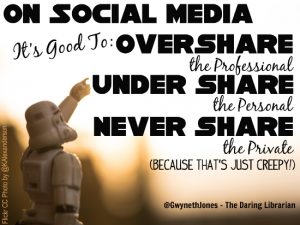
2. What is your philosophy on using social media in education?
The only way I use social media in school is to highlight and feature the amazing things happening every day. With Instagram and Vine tied to my Twitter, I like to catch my students being AWESOME. From shelfies (kids posing with books they’ve checked out) to science projects, robotics, school plays, to our Makerspace, this is an opportunity to connect with the community.
“We have the power to shift the mindset of the public sector if we shout out via social media the great things that kids do in our schools,” says Tony Sinanis and Dr. Joe Sanfelippo from the book The Power of Branding: Telling Your School’s Story, and I dig that! I also blogged about it, sharing more thoughts on how you can be the best PR person for your school, mainly by showing and shouting out the coolness! 
3. What are some ways to teach students how to use social media responsibly?
By modelling good social media use, creating our own positive digital footprint, and celebrating the AWESOME that goes on in our school every day. Teaching by doing it. Teaching by living it – every day.
4. What is the best way to coach your peers to use social media?
By encouragement, PD coaching, and modelling. Also, when teachers do join Twitter or other social media outlets, I try to be the first to follow them and retweet and pass on the cool content or everyday school moments they are sharing!
5. How do you model appropriate behaviour for using social media for both fellow educators and students?
I think it’s important to keep your interactions on social media authentic, real, and always professional. Being positive, passionate, and upbeat is a good thing, too!
6. How can social media teach digital literacy to students or create digital citizens?
We have digital citizen classes in our school – with content created by the tech leaders of our district. Again, the best way to teach is to be a good example – using social media positively, professionally, and ethically. On social media, you can push the positive and change the world, you can grow professionally by leaps and bounds, or you could get in really big trouble. Share thoughtfully, wisely, and well.
 Tyler Tarver
Tyler Tarver
For a couple of years, Tyler Tarver was a public school principal and is now the Director of Curriculum, Instruction, Federal Programs, Technology, & Communications for a 4A School District in Arkansas. He runs a popular YouTube channel covering various topics, from math lessons to personal family events. Tyler is the author of three books, hosts a humour podcast called Talk Hugs, and speaks at national conferences and events.
1. How do you use social media in your professional and personal lives?
We use everything we can to address our students and constituency within our district. Instagram, Snapchat, Twitter, Facebook, and our website are key players in this. We brag about every student and teacher we can. Personally, I use it to promote my YouTube education channels and photo/video work.
2. What is your philosophy on using social media in education?
Use is as much as possible to brag about as many people as possible.
3. What are some ways to teach students how to use social media responsibly?
We have a presentation to inform students on responsible student internet usage.
4. What is the best way to coach your peers to use social media?
We also provide this [presentation] for our teachers. We can summarize it to teachers by saying: stay positive, stay appropriate.
5. How do you model appropriate behaviour for using social media for both fellow educators and students?
Post things that are always positive or appropriate! Before posting, I recommend people text questionable materials to a conservative friend to get another opinion.
6. How can social media teach digital literacy to students or create digital citizens?
That’s the world we’re in, and it’s going to be even more intertwined in society in the coming years. We are in the process of creating courses and training for teachers and students to be responsible and informed! Post often and post great!
Tyler created this awesome video about Snapchat. You can also check out his playlist about social media.
Thanks to Gwyneth and Tyler for providing great insight from the perspective of two different roles within education. You can connect with them on Twitter at @GwynethJones and @tylertarver.




